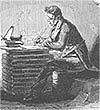
Β Γ Y Θ Τ Π

|
Sights - Chania Prefecture - Akrotiri |
|
|
Agia Triada Monastery |
|
|
Pashleys' description |
| Robert Pashley (1805-1859) was born in York. At the age of 20, he started as a law student at the University of Cambridge. In 1833 he obtained a permit to travel freely with the vessels of the English navy, which took him to the Ionian Islands, Albania, Greece, Asia Minor and Constantinople, and the following year to Crete. On his way back to England he stayed for a while in Venice, where he studied manuscripts in the St. Mark's Library. His book Travels in Crete was published in 1837. |
|
||
|
|
|||
| The road from this
spot to the monastery of Haghía Triádha runs near two or three villages,
without entering into any of them. The part of the Akrotéri over which it
passes is generally uncultivated, and seems to be barren. There is a great
abundance of game, especially red-legged partridges, on it. Haghía Triádha
is surrounded by many lofty cypresses, a long avenue of which leads up to
the principal entrance of the monastery. The Hegúmenos [abbot] is a venerable and communicative old man, with whom I had
much conversation.
|
|||
| This monastery is most substantially built: the church in the middle of its court is in the form of a Latin cross: its front is ornamented by Doric columns. Over its doorway is an inscription, the words of which are sufficiently appropriate in a convent dedicated to the Trinity. On the frieze of the entablature of this edifice are the capital letters | |||
|
Β Γ Y Θ Τ Π
|
|||
| A
conjectural explanation of them may be seen in the note*, if any one
should think it worth looking at. On either side of the doorway of this
church is an inscription: to the spectator's left in Greek, and to his
right in Latin. The purport of both is the same; and is to record the
names of the two founders of the monastery. The date affixed at the foot
of the Greek inscription is 1634, that over the principal entrance into
the monastery being 1631. The church was not quite finished when the Turks
obtained possession of Khaniá, and thus put a stop to the progress of the
building.
|
|||
| * Βάθος Γνώσεως, Ύψιστος Θεός, Τρισυπόστατος, Παντοκράτωρ | |||
|
(profundity
of cognition, God on high, the Trinity, the Almighty)
|
|||
| At the eastern corner
of the court is a small chapel, a view of which is seen at the head of
this chapter. Under it is the cemetery of the monastery. The graves have
nearly all been opened, so that the bones of their occupants lie exposed
to view, and each of them "grins horrible a ghastly smile" on
his visitors.
|
|
||
| This profanation of
the grave was committed by the Mohammedans, during the revolution, in the
vain hope of finding hidden treasure. In an apartment, with which this
burial-chamber communicates, dead men's skulls and bones are heaped up to
the height of about four feet. Above the doorway of the Golgotha, and in
many other places about the monastery, I noticed inscriptions, to some of
which a Latin translation is added.
|
|||
| The
old Hegúmenos assured me that, before the revolution broke out, there
were forty Patéres (priests
and monks) here, and ten more at the different metókhis or farms of
the monastery. They had then also thirteen Deacons. Although their arable
land was sufficient to employ thirty-five pairs of oxen, eighteen pairs on
the Akrotéri and the rest in the metókhis, yet, being so numerous a body,
they were always obliged to purchase corn. The produce of oil annually
sold by them may have amounted, according to the Hegúmenos, who is not
likely to exaggerate their wealth, to nearly two thousand místata [about
25 tonnes] . The present number of Patéres is ten.
|
|||